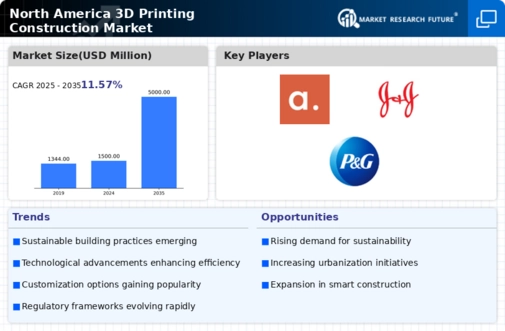Top Industry Leaders in the North America 3D Printing Construction Market

The North American 3D printing construction market, where futuristic visions meet tangible buildings, is poised for explosive growth. This growth is driven by factors like speed, efficiency, reduced waste, and design freedom, attracting both construction giants and innovative startups. But navigating this exciting terrain requires understanding the intricate dance of strategies, market share determinants, and the constant evolution of news and developments.
Strategies Shaping the Landscape:
-
Industry Leaders: Construction giants like Bechtel, Skanska, and LafargeHolcim leverage their experience, resources, and established partnerships to pioneer large-scale 3D printed projects. Their strategies focus on developing proprietary printing technologies, collaborating with material suppliers, and demonstrating economic feasibility. -
Material Specialists: Companies like CEMEX and BASF leverage their expertise in construction materials to develop and supply specialized inks and concrete mixes optimized for 3D printing. Their strategies involve building strategic partnerships with printer manufacturers and construction firms, ensuring material compatibility and project success. -
Technology Innovators: Startups like ICON and Branch Technology disrupt the market with innovative printing technologies and unique printing materials. They capitalize on agility, niche expertise, and partnerships with early adopters, focusing on specific applications like affordable housing or disaster relief shelters.
Factors Dictating Market Share:
-
Printing Technology Efficiency and Speed: Offering faster printing speeds, larger build volumes, and reliable operation attracts a wider range of projects and increases market share. Continuous R&D and optimization are crucial for staying ahead of the curve. -
Material Performance and Cost-Effectiveness: Developing inks and mixes with superior strength, durability, and weather resistance while maintaining competitive pricing is essential for gaining market acceptance. Collaborations and material innovation are key. -
Regulatory Compliance and Building Codes: Adhering to evolving building codes and obtaining necessary approvals for printed structures builds trust and opens doors to wider project opportunities. Industry advocacy and collaboration with regulatory bodies are crucial. -
Project Expertise and Design Optimization: Providing comprehensive design, engineering, and construction expertise tailored for 3D printed structures differentiates players and attracts complex projects. Developing design software and building partnerships with architects and engineers is vital. -
Sustainability and Environmental Impact: Utilizing recycled materials, minimizing waste, and reducing energy consumption during printing resonates with environmentally conscious clients and opens doors to sustainable construction projects.
Key Players:
-
Skanska AB
-
Mighty Buildings
-
Apis Cor
-
Aeditive
-
Branch technology
-
Aectual
-
Sika AG
-
Peri group
-
ICON Technology Inc.
-
Constructions-3D
-
Winsun
-
XtreeE
Recent Developments :
-
September 2023: Skanska partners with a leading concrete mix supplier to develop a new, eco-friendly concrete specifically formulated for 3D printing, minimizing environmental impact. -
October 2023: Branch Technology secures funding for a new production facility dedicated to printing prefabricated building components, aiming to accelerate construction timelines. -
November 2023: A team of researchers at MIT develops a novel 3D printing technique using recycled plastic waste, promoting sustainability in the construction industry. -
December 2023: LafargeHolcim launches a new training program for architects and engineers on designing and specifying 3D printed structures, fostering wider adoption of the technology.
